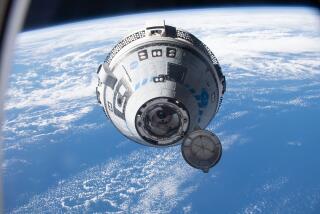Space Station Work Remains Up in the Air
MONTEREY — With the assembly of the international space station on hold since the Columbia accident on Feb. 1, NASA said Tuesday it is still not sure how long the completion of the outpost will be delayed.
The chiefs of space agencies from around the world held their first summit since the accident this week, attempting to understand how the grounding of the space shuttle fleet will affect the long-term future of the station.
About 60 space officials from the United States, Russia, Japan, Canada and Europe gathered at the Naval Postgraduate School in Monterey to discuss the issue.
NASA Administrator Sean O’Keefe said after the summit that he still believes the shuttles can resume flying in late winter or early spring.
Nonetheless, the situation has left on the backburner a number of important questions about use of the space station and left unclear when it can house a full complement of astronauts. Japan, for example, is waiting to get a chance to put someone aboard.
But those involved in the international space program have said they would support NASA while it deals with the Columbia accident and its aftermath.
“The Columbia tragedy is not just NASA’s tragedy -- it’s our tragedy,” said Jean-Jacques Dordain, director general of the European Space Agency.
On Tuesday, the station marked the 1,000th day of human habitation, though the crew is now limited to two astronauts, an American and a Russian, aboard the partly completed craft. In the meantime, scientific activity has been sharply scaled back.
In the early days of the program, NASA had envisioned completing the space station by 2004, but that proved to be overly ambitious. Even before the Columbia disaster, NASA had indicated final completion would not occur until 2008. Now, it can’t say when that objective will be reached.
If the shuttles resume flights by late spring, work on the space station would be about 14 months behind the schedule it was on before the shuttle disaster. But that delay could stretch out even further.
O’Keefe said it will take six additional space shuttle flights to complete the basic core of the space station. In years past, the shuttles easily flew that many times in a year, but there are many unknowns now.
Future space shuttle flights to the space station will face a number of difficult limitations after the Columbia accident. Only a limited number of launch windows exist that would satisfy all the new conditions, and those could complicate NASA’s efforts to complete the station as quickly as possible, O’Keefe said.
All future flights must occur during daylight so that ground cameras can assess whether any debris has struck the orbiter. Foam debris striking Columbia’s wing during liftoff is believed to have been the cause of the Columbia accident.
The flights also must occur when communications are unimpeded by radiation effects from space. And the launches must be timed to rendezvous with the space station, which flies in a high orbital inclination above Earth.
The fact that even two astronauts can stay aboard the station has been made possible by additional support from Russia, which has increased its number of flights to the station, according to Russian space agency chief Yuri Koptev.
“Of course, it is an additional burden,” Koptev said. “Under the circumstances, there is no alternative. It cannot be any other way.”
Koptev spoke at length Tuesday about the importance of the international community supporting the space station and NASA after the Columbia tragedy.
“We reaffirm the Russian commitment to this program,” he said at a news conference.
Similar statements of support were issued by the other international partners.
More to Read
Sign up for Essential California
The most important California stories and recommendations in your inbox every morning.
You may occasionally receive promotional content from the Los Angeles Times.











